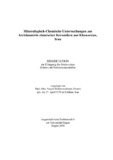Citation link:
https://nbn-resolving.org/urn:nbn:de:hbz:467-3603| Dokument Type: | Doctoral Thesis | metadata.dc.title: | Mineralogisch-chemische Untersuchungen zur Archäometrie elamischer Keramiken aus Khouzestan, Iran | Other Titles: | Mineralogical-chemical investigations to the archaeometry of elamite ceramic(s) from Khouzestan, Iran | Authors: | Emami, Seyed Mohammadamin | Institute: | Fachbereich 8, Chemie - Biologie | Free keywords: | Tschogha Zanbil, Khouzestan, 14. Jahrhundert v. Chr., Chemie, Mineralogie, mineralogy, chemistry, ceramic, archaeometry, 14th century b.c. | Dewey Decimal Classification: | 540 Chemie | GHBS-Clases: | UYG | Issue Date: | 2008 | Publish Date: | 2009 | Abstract: | Schwerpunkt dieser Arbeit ist die Charakterisierung keramischer Werkstoffe, die im Altertum des heutigen Irans (14. Jh. v. Chr.) hergestellt und genutzt wurden. Aus den Erkenntnissen sollen Rückschlüsse auf die historischen Technologien, die verwendeten Rohstoffe und die Herkunft der Keramiken abgeleitet werden. Materialwissenschaftliche Untersuchungen sind bei den antiken Keramiken unerlässlich, da sich anhand ihrer chemisch-mineralogischen Zusammensetzung Aufschlüsse über ihren jeweiligen Entstehungsprozess ergeben. Rontgenfluoreszenzanalysen zeigen, dass die untersuchten Keramiken als kalkreiche Keramiken klassifiziert werden konnen, die sich im System SiO2-Al2O3-(CaO+MgO) im Bereich Diopsid-Gehlenit-Anorthit-Quarz befinden. Die Bestimmung des kristallinen Phasenbestands wurde mit Hilfe der quantitativen Rietveld-Analyse durchgeführt und die Ergebnisse zeigen Variationen je nach Lokalität und Verfahrenstechnik der entsprechenden Epoche. Durch mikroskopische Untersuchungen werden Aussagen hinsichtlich der Bestimmung lokalbezogener Zuschlagstoffe (effektive Magerung) der Keramiken ermoglicht. Quarz, Calcit, Feldspäte und Pyroxene sind die Hauptbestandteile der Magerung, wobei Feldspäte und Calcit auch als Flussmittel eingesetzt wurden. Kaolinitisierung sowie Sericitisierung bei Feldspäten deuten auf einen hohen Entwässerungsgrad des Phasenbestandes hin. Rasterelektronenmikroskopische Beobachtungen stützen ein abgeleitetes Modell für den Schädigungsmechanismus anhand der Storungsstrukturen. Die Untersuchungen wurden durch die Rastersondenmikroskopie weiter ergänzt, diese ermoglichte eine topographische Darstellung der Storungsstrukturen sowie die qualitative und quantitative Beschreibung der Morphologie der Sinterstrukturen in den keramischen Matrices (Interface). Thermoanalytische Messungen ergaben, dass die Brenntemperatur in den Gebieten von Čoġā Zanbil und Haft Tappeh bei ca. 900-1010°C lag. Anhand der Ergebnisse der mineralogisch-chemischen Untersuchungen wurde bewiesen, dass die lokal vorhandenen Rohstoffe zur Herstellung der Keramiken im 14. Jh. v. Chr. genutzt wurden. The main purpose of our identification is the characterization of old ceramics' textures and the determination of the technical process, as well as the crystallization sequences, during ceramic fabrication in the ancient world. The origin of the material examined is related to areas of the Elamite period (1500 B.C.) in the south-west of Iran. Examinations in the area of material science are absolutely necessary for ancient ceramics as the process by which they were created, can be categorised as function of their chemical-mineralogical composition. Many ceramics' constituents were classified as Ca-rich ceramics. They will be classified in the system SiO2-Al2O3-(CaO+MgO). The main paragenesis is Diopside-Gehlenite-Anorthite-Quartz. In some cases, the Ca variation depends on the calcareous rocks which have been used in the pottery production. The crystalline phase composition was determined by quantitative X-Ray diffraction measurements with the Rietveld refinement method. The results have been matched with microscopic methods in order to come to a chemical-petrological conclusion about phase segregation. Quartz, Calcite and Pyroxene are the main temper constituents. Feldspars and Calcite are flux materials in the ceramic body. Kaolinitization and sericitization prove a high dehydration during the fabrication process which favored with respect to the K+/Al3+ ratios. The element distribution of the grain-interface-matrix structure was determined by EDX-measurements and enhanced with the physico-chemical properties of these structures. SFM measurements were carried out at adequate points: here either AFM with the use of pulsed force mode or scattering and absorption properties with SNOM were studied. The firing temperature during the process was also studied by thermoanalytical methods and is approximately 900-1010°C. Examinations determine also that local raw material has been used for ceramic fabrication and the technology in this region was also local technology. |
URN: | urn:nbn:de:hbz:467-3603 | URI: | https://dspace.ub.uni-siegen.de/handle/ubsi/360 | License: | https://dspace.ub.uni-siegen.de/static/license.txt |
| Appears in Collections: | Hochschulschriften |
This item is protected by original copyright |
Page view(s)
452
checked on Nov 25, 2024
Download(s)
140
checked on Nov 25, 2024
Google ScholarTM
Check
Items in DSpace are protected by copyright, with all rights reserved, unless otherwise indicated.


